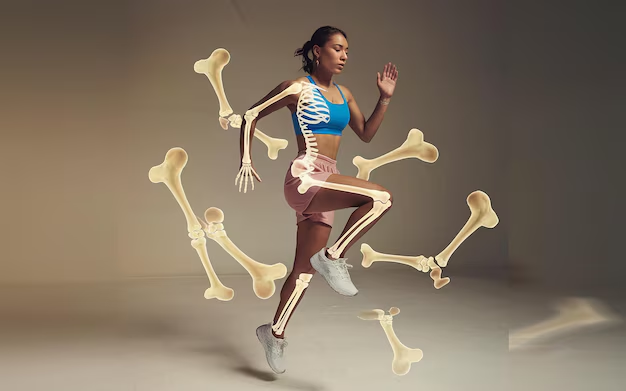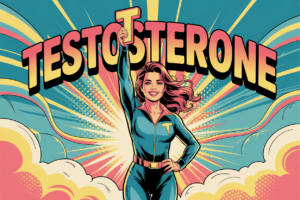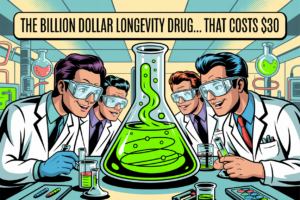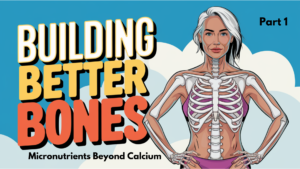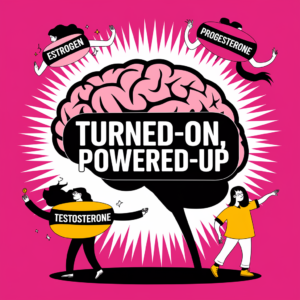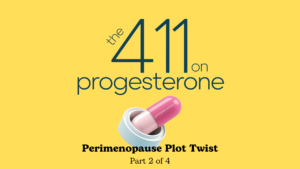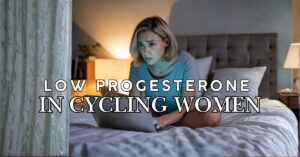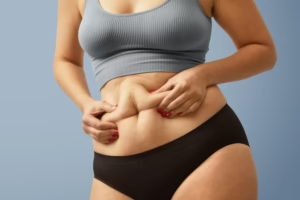As we age, bone health becomes a real concern, but most of us aren’t addressing the root causes early enough. In fact, you can prevent bone loss and even increase bone density with simple daily habits, like just 50 jumps a day.
Research proves it.
Postmenopausal women who jumped daily saw a 1.5% increase in bone mineral density in just a year.
This isn’t about magic pills; it’s about knowing the correct movements, foods, and the testing methods that keep your bones strong and resilient. Ready to discover how to keep your skeleton healthy for life?
Let’s break it down.
Movement – The Bone-Building Power of Exercise
Exercise is your best ally when it comes to strengthening bones. Just like muscles, bones adapt to stress. The more stress they’re under, in a controlled, safe way, the stronger they become. This is mechanical loading, which simply means creating stress on the bones through weight-bearing or impact exercises. When you engage in activities like jumping, walking, or resistance training, you’re putting stress on your bones, telling your body, “We need to get stronger here.”
To understand this better, consider mechanical loading as bending a metal rod. Over time, as you apply force, the metal becomes stronger. Similarly, when you place stress on your bones, you trigger a biological process that helps them regenerate and become denser.
Impact-Based Exercises – The Role of Jumping and Weight-Bearing Movements
Jumping is a power move for bone health. When your feet hit the ground, you create forces 4-8 times your body weight. This kind of force helps activate the piezoelectric currents in your bone tissue, which are like electrical signals that tell your bones to strengthen.
In a study of postmenopausal women, those who did just 50 jumps a day (about 10 cm in height) saw a 1.5% increase in their hip bone mineral density over a year. While this increase may seem small, it can be the difference between maintaining bone strength and losing it. These findings support the idea that simple, low-intensity activities can substantially impact long-term bone health.
Now, if jumping isn’t possible for you—perhaps due to joint issues or other limitations—don’t worry. There are plenty of alternative exercises that provide similar benefits:
- Step aerobics: This can also create the ground reaction force your bones need to stay strong.
- Tennis or pickleball: Sports with rapid direction changes stimulate bone formation.
- Dancing: Anything with quick, high-impact movements can also help your bones.
- Walking with a weighted vest: Even a low-impact option like walking can work as a bone-strengthening exercise when paired with extra weight.
The goal here is to stress your bones appropriately, making them work to get stronger.
Resistance Training – Your Bone Builder’s Best Friend
Image: Freepik
Weightlifting doesn’t just build muscle—it also helps build bone. When you lift weights, your body produces Insulin-like Growth Factor 1 (IGF-1), a hormone that plays a critical role in stimulating bone-building processes. Research shows that working at 70-85% of your max capacity can increase IGF-1 by 20%, leading to stronger bones.
Focus on compound movements like squats, deadlifts, and presses to build bone density. These exercises engage multiple muscle groups and are particularly effective at promoting bone growth. Aim for 3 weekly resistance training sessions, performing 2-3 sets of 8-12 repetitions.
For even better results, consider combining resistance training with collagen supplementation. Studies suggest that collagen, particularly Fortibone collagen peptides, can boost trabecular bone volume by up to 18% when combined with weightlifting.
Key takeaway:
Exercise creates the demand for bone-building, and collagen provides the building blocks.
Nutrition – Fueling Your Bones for Strength
A Mediterranean diet does more than just support heart health—it’s also fantastic for your bones. Rich in polyphenols—antioxidants found in fruits, vegetables, and olive oil—this diet helps reduce inflammation and suppress osteoclasts, the cells that break down bone. But what makes it even more powerful is its emphasis on healthy fats, which are essential for bone health.
In addition, the Mediterranean diet focuses on a healthy balance of omega-3s and omega-6s, which reduces inflammation and keeps bone resorption at bay. This balance is important because the typical Western diet often has too many omega-6 fatty acids, which can promote inflammation and lead to bone loss.
Calcium, Protein, and Other Bone Nutrients
You might already know that calcium is crucial for strong bones. However, it’s important to understand that calcium alone won’t cut it. For truly resilient bones, you need a range of nutrients. Here’s what you should prioritize:
- Calcium: Aim for 4-5 servings of calcium-rich foods daily. These could include dairy, leafy greens, and sardines with bones.
- Protein: Protein is crucial for bone health because it stimulates osteoblasts, the cells that build bone. Aim for 1.2 grams per kilogram of body weight daily.
- Phytoestrogens: For those in menopause, phytoestrogens from foods like tempeh, edamame, and flaxseeds can help mitigate the effects of reduced estrogen levels, promoting stronger bones.
Remember: Smoking and excessive alcohol consumption can damage your bones. Quitting smoking and cutting back on alcohol can lower your risk of fractures by up to 21% and 18%, respectively.
Testing and Monitoring – Tracking Your Bone Health Progress
Image: Freepik
A DEXA scan is a common tool for measuring bone mineral density, but it doesn’t give you the full picture. To truly understand how your bones are doing, you need to look at bone turnover markers. These markers tell you whether your bones are breaking down faster than they’re rebuilding.
The two most important markers to track are CTX/NTX (which measure bone resorption) and P1NP (which measures bone formation). Monitoring these biomarkers gives you a more accurate picture of your bone health than relying on DEXA scans alone.
- CTX/NTX: Elevated levels of these markers indicate accelerated bone breakdown.
- P1NP: High levels of P1NP show that your body is actively building new bone.
By keeping an eye on these markers, you can track your progress and adjust your strategy accordingly.
How to Get These Tests – The Path to Better Monitoring
Most conventional doctors don’t routinely order bone turnover marker tests, but you can request them. Functional medicine practitioners are often more familiar with these markers, or you can use direct-to-consumer testing services like Life Extension and Ulta Lab Tests. These companies offer bone marker panels without needing a doctor’s prescription.
Putting It All Together – Your Bone Health Blueprint
The modern approach to bone health isn’t just about calcium. It’s about a comprehensive strategy that includes movement, nutrition, and testing. Here’s your blueprint for success:
- Daily Supplementation:
- 2000 – 5000 IU vitamin D3 (or get some sun)
- 180 mcg vitamin K2 (as MK-7)
- 5 grams Fortibone collagen peptides
- 120 mg magnesium glycinate
- Weekly Movement:
- 150 minutes of combined impact and resistance training
- Consider adding vibration therapy for enhanced results
- Advanced Monitoring:
- DEXA scan every two years post-menopause
- CTX/NTX and P1NP testing every 6-12 months
By following this blueprint, you can create a holistic strategy that supports bone health in every way possible.
A Lifetime of Bone Health Awaits
Your bones are far more dynamic than you might think. They respond to stress, nutrition, and even electrical signals, becoming stronger with the right care. But the key is starting early and being consistent. By incorporating movement, eating the right foods, and tracking your progress, you’re setting yourself up for a lifetime of bone health.
Don’t wait for a problem to arise. Start now. Your bones will thank you in the future.
Want to learn more about building and maintaining healthy bones? Join us for more tips and expert insights on keeping your body strong and resilient throughout your life. Stay tuned for upcoming articles, and don’t forget to share this one with someone who needs to hear it. Your future self will be glad you did!
Disclaimer: This content is for informational purposes only and should not be considered medical advice. Always consult with your healthcare provider before making changes to your diet, exercise routine, or introducing new supplements or treatments.
